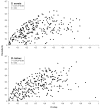Gut Bacterial Communities in Geographically Distant Populations of Farmed Sea Bream (Sparus aurata) and Sea Bass (Dicentrarchus labrax)
- PMID: 30200504
- PMCID: PMC6164763
- DOI: 10.3390/microorganisms6030092
Gut Bacterial Communities in Geographically Distant Populations of Farmed Sea Bream (Sparus aurata) and Sea Bass (Dicentrarchus labrax)
Abstract
This study investigated the profile of the autochthonous gut bacterial communities in adult individuals of Sparus aurata and Dicentrarchus labrax reared in sea cages in five distantly located aquaculture farms in Greece and determine the impact of geographic location on them in order to detect the core gut microbiota of these commercially important fish species. Data analyses resulted in no significant geographic impact in the gut microbial communities within the two host species, while strong similarities between them were also present. Our survey revealed the existence of a core gut microbiota within and between the two host species independent of diet and geographic location consisting of the Delftia, Pseudomonas, Pelomonas, Propionibacterium, and Atopostipes genera.
Keywords: aquaculture; bacteria; intestine; microbiota; teleosts.
Conflict of interest statement
The authors declare no conflicts of interest.
Figures



Similar articles
-
Study of the microbiological quality, prevalence of foodborne pathogens and product shelf-life of Gilthead sea bream (Sparus aurata) and Sea bass (Dicentrarchus labrax) from aquaculture in estuarine ecosystems of Andalusia (Spain).Food Microbiol. 2020 Sep;90:103498. doi: 10.1016/j.fm.2020.103498. Epub 2020 Mar 26. Food Microbiol. 2020. PMID: 32336378
-
Discriminating farmed gilthead sea bream Sparus aurata and European sea bass Dicentrarchus labrax from wild stocks through scales and otoliths.J Fish Biol. 2012 May;80(6):2159-75. doi: 10.1111/j.1095-8649.2012.03236.x. Epub 2012 Mar 9. J Fish Biol. 2012. PMID: 22551175
-
Scarcity of parasite assemblages in the Adriatic-reared European sea bass (Dicentrarchus labrax) and sea bream (Sparus aurata).Vet Parasitol. 2010 Nov 24;174(1-2):131-8. doi: 10.1016/j.vetpar.2010.08.015. Epub 2010 Aug 22. Vet Parasitol. 2010. PMID: 20837380
-
Haematology reference values for Dicentrarchus labrax and Sparus aurata: A systematic review and meta-analysis.J Fish Dis. 2022 Oct;45(10):1549-1570. doi: 10.1111/jfd.13680. Epub 2022 Jun 30. J Fish Dis. 2022. PMID: 35771971
-
Importance of prebiotics in aquaculture as immunostimulants. Effects on immune system of Sparus aurata and Dicentrarchus labrax.Fish Shellfish Immunol. 2016 Jul;54:172-8. doi: 10.1016/j.fsi.2016.04.011. Epub 2016 Apr 10. Fish Shellfish Immunol. 2016. PMID: 27074444 Review.
Cited by
-
Configuration of Gut Microbiota Structure and Potential Functionality in Two Teleosts under the Influence of Dietary Insect Meals.Microorganisms. 2021 Mar 28;9(4):699. doi: 10.3390/microorganisms9040699. Microorganisms. 2021. PMID: 33800578 Free PMC article.
-
Sparus aurata and Lates calcarifer skin microbiota under healthy and diseased conditions in UV and non-UV treated water.Anim Microbiome. 2022 Jun 21;4(1):42. doi: 10.1186/s42523-022-00191-y. Anim Microbiome. 2022. PMID: 35729615 Free PMC article.
-
Relationship Between the Fatty Acid Profiles and Gut Bacterial Communities of the Chinese Mitten Crab (Eriocheir sinensis) From Ecologically Different Habitats.Front Microbiol. 2020 Oct 15;11:565267. doi: 10.3389/fmicb.2020.565267. eCollection 2020. Front Microbiol. 2020. PMID: 33178151 Free PMC article.
-
Midgut Bacterial Microbiota of 12 Fish Species from a Marine Protected Area in the Aegean Sea (Greece).Microb Ecol. 2023 Aug;86(2):1405-1415. doi: 10.1007/s00248-022-02154-x. Epub 2022 Dec 19. Microb Ecol. 2023. PMID: 36529834 Free PMC article.
-
Crosstalk Between Culturomics and Microbial Profiling of Egyptian Mongoose (Herpestes ichneumon) Gut Microbiome.Microorganisms. 2020 May 27;8(6):808. doi: 10.3390/microorganisms8060808. Microorganisms. 2020. PMID: 32471180 Free PMC article.
References
-
- Sullam K.E., Essinger S.D., Lozupone C.A., O’Connor M.P., Rosen G.L., Knight R.O.B., Kilham S.S., Russell J.A. Environmental and ecological factors that shape the gut bacterial communities of fish: A meta-analysis. Mol. Ecol. 2012;21:3363–3378. doi: 10.1111/j.1365-294X.2012.05552.x. - DOI - PMC - PubMed
LinkOut - more resources
Full Text Sources
Other Literature Sources

